Yuri Lyubchenko, PhD, DSc

Research in the Lyubchenko lab (Pharmaceutical Nanoimaging and Nanoengineering Laboratory, PNNL) focuses on understanding fundamental mechanisms underlying health and disease, which are key to developing new and more effective diagnostics and medications. This primarily basic research allows us not only identifies new drug targets for small molecule drugs, it also develops the tools and methods to discover novel approaches for diagnostic, treatment and disease prevention and to more rapidly determine their efficacy at the molecular level. The research is categorized into three broad areas, with interplay and overlap among them (1) Structural genomics in relation to cancer and other diseases, (2) Molecular mechanisms Alzheimer’s, Parkinson’s and other protein aggregation diseases, (3) Protein-DNA interactions for novel approaches for HIV restriction. We also have a keen interest in new and innovative instrumentation, working on development of novel nanoimaging and nanoprobing approaches.
The projects are funded by NSF and NIH grants.
In area 1, the structural genomic area we discovered highly dynamic inherent property of nucleosomes based on the direct imaging of nucleosomes with time lapse AFM and identified a critical role of electrostatics in their spontaneous dynamics. The current project deals with characterization of centromere chromatin. Centromeres are specialized segments of chromosomes that aid in faithful chromosomal segregation after DNA replication. If the centromere becomes damaged or removed, chromosomes segregate randomly triggering cancer development. We proposed a model according to which changes in the nucleosome wrapping lead to considerable changes in the CENP-A nucleosome array. The application of the cutting-edge high-speed AFM approach led to the discovery that that CENP-A stabilizes nucleosome core particles against complete dissociation even when they are not fully wrapped with DNA. The stability of centromeric nucleosomes is a critical property of centromeres. This novel property of CENP-A permits rapid nucleosome re-assembly following mitosis, transcription or replication induced eviction. This behavior of CENP-A might then contribute to its longevity on the chromatin fiber, thus contributing to the cell cycle independent “memory” of centromeric chromatin over several cell cycles.
The availability of new AFM methodology was critical for his studies of the interaction of site-specific DNA binding proteins as well as regulation of DNA replication and recovery from stalling of the replication machinery. These studies led to the discovery a novel property of SSB protein that in the interaction with RecG protein it works as a remodeling protein. This remodeling changes the mode of RecG-replication fork interaction allowing the protein to slide along the parental arm of the replication fork. Single-molecule high-speed AFM approach made it possible to directly visualize this effect.
Area 2: molecular mechanisms Alzheimer’s, Parkinson’s and similar protein misfolding diseases
We developed novel approaches for probing aggregation-prone transient states of amyloid proteins with AFM force spectroscopy. The major discovery is that a misfolding amyloid dimer has an extremely long lifetime in comparison with the fast conformational dynamics of monomers. Such stabilization dramatically facilitates the aggregation kinetics and thus triggers the entire aggregation process. This conclusion is in line with recent findings on the critical role of dimers in the self-assembly of proteins and is further supported by theoretical analyses in which he utilizes the most powerful computational resources in the nation. The combination of nanoimaging techniques with high-power computational modeling led to the discovery a novel pathway for spontaneous assembly of amyloid peptides and proteins that occurs at the physiological concentration range. These novel findings not only eliminate a major problem with understanding the spontaneous appearance of plaques in the brain of Alzheimer’s patients at physiological range of protein concentrations, but reveals a number of important properties of the on-surface aggregation process. A novel model of the amyloid aggregates assembly in which change in membrane properties leading to an increase in affinity of amyloid proteins to the membrane surface triggers the disease-related aggregation process. The proposed model is a significant departure from the current model in which amyloid aggregation is linked with elevated synthesis of amyloid proteins. This is a paradigm shift in the development of efficient treatments and diagnostics for protein aggregation neurodegenerative diseases.
Area 3: protein-DNA interactions and development of approaches for HIV restriction
In this area, we are working on approaches utilizing factors that provide innate immunity against HIV-1. We has developed advanced experimental AFM approaches that allowed him to characterize, at the nanoscale, complexes formed by A3G HIV restriction factor and ssDNA. These techniques enabled us to directly image the sliding of A3G along the substrate. Furthermore, he discovered and characterized the process where A3G self-assembles into oligomers. Together, these studies determined a number of novel features of A3G-ssDNA complexes, thus paving the road for new therapeutic interventions. These approaches are discussed at regular annual NIH/NIGMS meetings “Structural Biology Related to HIV/AIDS” at which Lyubchenko is invited to speak.
Dr. Lyubchenko is getting invitations for editing books by the top publishers. The CRC Press has published an edited textbook “An Introduction to Single Molecule Biophysics” that has two chapters prepared by Lyubchenko’s lab. He recently finished the Nanoimaging volume for book series Methods in Molecular Biology, publishing by Springer Nature. Over 1500 books have been published to date in this book series widely used by biomedical scientists. He was the editor of two issues for the journal Methods (Elsevier), which cover advances in methods for the single molecule biophysics area. Both issues present advances in this area with publications from Lyubchenko’s laboratory.
Research projects are illustrated in the file AFM containing movies taken from the AFM time-lapse experiments. More movies can be found on journal’s sites.
College of Pharmacy
Department of Pharmaceutical Sciences
University of Nebraska Medical Center
986025 Nebraska Medical Center
Omaha, NE 68198-6025
402-559-1973 (Lab)